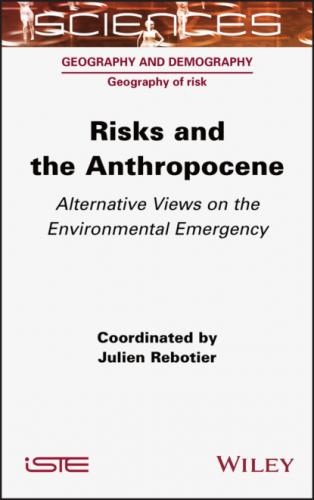Lovelock, J. and Margulis, L. (1974). Atmospheric homeostasis by and for the biosphere: The Gaia hypothesis. Tellus, 26(1–2), 2–10.
Malm, A. and Hornborg, A. (2014). The geology of mankind? A critique of the Anthropocene narrative. The Anthropocene Review, 1(1), 62–69.
Marsh, G.P. (1865). Man and Nature; or Physical Geography as Modified by Human Action. C. Scribner, New York.
Maskrey, A. (ed.). (1993). Los desastres no son naturales. La Red, Panama [Online]. Available at: www.desenredando.org/public/libros/1993/ldnsn/LosDesastresNoSonNaturales-1.0.0.pdf [Accessed 8 May 2020].
Mathieu, N. and Jollivet, M. (1989). Du rural à l’environnement. Penser les changements socio-écologiques. L’Harmattan, Paris.
Mercer, J. (2012). Knowledge and disaster risk reduction. In The Routledge Handbook of Hazards and Disaster Risk Reduction, Wisner, B., Gaillard, J-C., Kelman, I. (eds). Routledge, New York.
Metzger, P. (2017). Connaissances et relations de pouvoir : les sciences sociales, les risques et l’environnement. HDR Thesis, Université Grenoble Alpes, Grenoble.
Metzger, P. and Robert, J. (2015). Environnement et risques : les sciences sociales piégées entre critique radicale et utilité sociale. In Espaces et rapports de domination, Clerval, A., Fleury, A., Rebotier, J., Weber, S. (eds). PUR, Rennes.
Moore, J. (2003). Capitalism as world-ecology. Braudel and Marx on environmental history. Organization and Environment, 16(4), 431–458.
Moore, J. (2017a). The Capitalocene part I: On the nature and origins of our ecological crisis. The Journal of Peasant Studies, 44(3), 594–630.
Moore, J. (2017b). Confronting the popular Anthropocene. Toward an ecology of hope. New Geographies, 9, 186–191.
Moore, J. (2017c). The road to ruin? Making sense of the Anthropocene. IPPR Progressive Review, 24(3), 176–202.
Moore, J. (2018). The Capitalocene part II: Accumulation by appropriation and the centrality of unpaid work/energy. The Journal of Peasant Studies, 45(2), 237–279.
Mumford, L. (1950). Technique et civilisation. Le Seuil, Paris.
O’Brien, K., Eriksen, S., Nygaard, L.P., Schjolden, A. (2007). Why different interpretations of vulnerability matter in climate change discourses. Climate Policy, 7(1), 73–88.
O’Keefe, P., Westgate, K., Wisner, B. (1976). Taking the naturalness out of natural disasters. Nature, 260(5552), 566–567.
Oliver-Smith, A., Alcántara-Ayala, I., Burton, I., Lavell, A. (2017). The social construction of disaster risks: Seeking root causes. International Journal of Disaster Risk Reduction, 22, 469–474.
Pahl-Wostl, C. (2009). A conceptual framework for analysing adaptive capacity and multi-level learning processes in resource governance regimes. Global Environmental Change, 19(3), 354–365.
Palsson, G., Szerszynski, B., Sörlin, S., Marks, J., Avril, B., Crumley, C., Hackmann, H., Holm, P., Ingram, J., Kirman, A., Pardo Buendía, M., Weehuizen, R. (2013). Reconceptualizing the “Anthropos” in the Anthropocene: Integrating the social sciences and humanities in global environmental change research. Environmental Science and Policy, 28, 3–13.
Passeron, J.-C. (1995). L’espace mental de l’enquête (I). Enquête, 1, 13–42.
Peet, R. and Watts, M. (1996). Liberation Ecologies. Environment, Development and Social Movements. Routledge, London.
Pelletier, P. (1993). L’imposture écologiste. Reclus, Montpellier.
Pelling, M. (2010). Adaptation to Climate Change: From Resilience to Transformation. Routledge, London.
Pigeon, P. and Rebotier, J. (2016). Disaster Prevention Policies. A Challenging and Critical Outlook. ISTE Press, London, and Elsevier, Oxford.
Rebotier, J. (2020). Adaptation. In Dictionnaire critique de l’anthropocène, Cynorhodon (ed.). CNRS Édition, Paris.
Rebotier, J., Pigeon, P., Metzger, P. (2019). Returning social context to seismic risk knowledge & management. Lessons learned from an interdisciplinary research in the city of Esmeraldas, Ecuador. Cybergeo: European Journal of Geography [Online]. Available at: https://journals.openedition.org/cybergeo/31787 [Accessed 11 May 2020].
Ribot, J. (2014). Cause and response: Vulnerability and climate in the Anthropocene. Journal of Peasant Studies, 41(5), 667–705.
Ribot, J. (2019). Social causality of our common climate crisis: Toward a sociodicy for the Anthropocene. In The Commons in a Glocal World: Global Connections and Local Responses, Haller, T., Breu, T., De Moor, T., Rohr, C., Znoj, H. (eds). Routledge, London.
Robbins, P. (2004). Political Ecology: A Critical Introduction. Blackwell Publishing, Hoboken, NJ.
Robic, M.-C. (ed.) (1992). Du milieu à l’environnement : pratiques et représentations du rapport homme-nature depuis la Renaissance. Economica, Paris.
Robic, M.-C. (ed.) (2006). Couvrir le monde. Un grand XXe siècle de géographie française. ADFP, Paris.
Rodríguez, H., Quarantelli, E.L., Dynes, R.R. (2007). Handbook of Disaster Research. Springer, New York.
Rossi, G. (2001). L’ingérence écologique. CNRS Éditions, Paris. Servigne, P. and Stevens, R. (2015). Comment tout peut s’effondrer. Le Seuil, Paris.
Shaw, R. (2013). Disaster risk reduction and community approaches. In Community Practices for Disaster Risk Reduction in Japan, Shaw, R. (ed.). Springer, Tokyo.
Smith, N. (2010). Uneven Development: Nature, Capital, and the Production of Space, 3rd edition. University of Georgia Press, Athens, London.
Steffen, W., Crutzen, P.J., McNeill, J.R. (2007). The Anthropocene: Are humans now overwhelming the great forces of nature? Ambio, 36(8), 614–621.
Steffen, W., Broadgate, W., Deutsch, L., Gaffney, O., Ludwig, C. (2015). The trajectory of the Anthropocene: The Great Acceleration. The Anthropocene Review, 2(1), 81–98.
Theys, J. and Fabiani, J.-L. (eds) (1987). La société vulnérable. Évaluer et maîtriser les risques. Presses de l’École normale supérieure, Paris.
Tissier, J.-L. (1992). La géographie dans le prisme de l’environnement (1970–1990). In Du milieu à l’environnement : pratiques et représentations du rapport homme-nature depuis la Renaissance, Robic, M.-C. (ed.). Economica, Paris.
Tsing, A. (2017). Le champignon de la fin du monde. La Découverte, Paris.
White, G.F., Kates, R.W., Burton, I. (2001). Knowing better and losing even more: The use of knowledge in hazards management. Global Environmental Change Part B: Environmental Hazards, 3(3–4), 81–92.
Wisner, B. (2016). Vulnerability as model, concept, metric and tool. Oxford Research Encyclopedia [Online].
